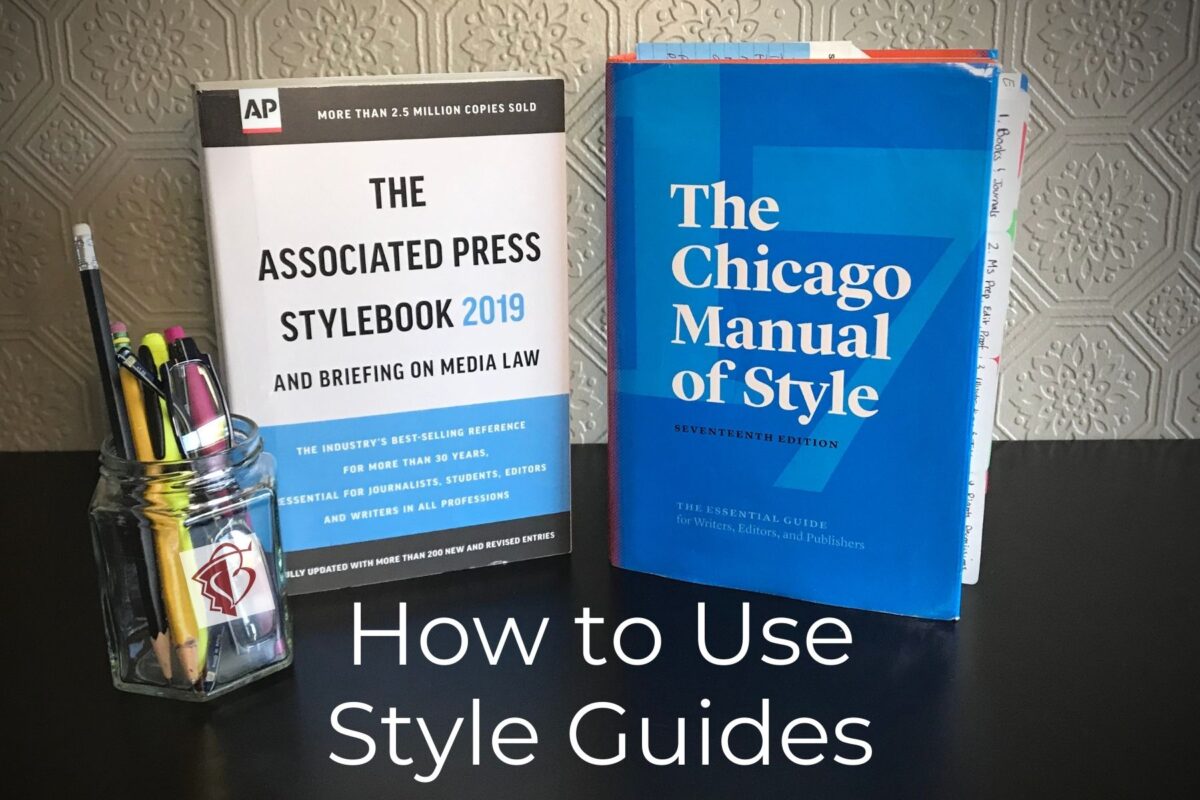A piece of writing should be as precise, smooth, and clear as possible. To that end, it should follow the conventions of grammar, syntax, formatting, and style. (Yes, rules are sometimes broken to great effect, and there may be exceptions, but usually writing should follow these conventions.)
What is style?
Style covers myriad elements, such as whether numbers should be written as numerals, when to use abbreviations, whether a list should be bulleted or numbered, which words should be hyphenated or capitalized, how to cite source material, and so on. Why do these details matter? To aid the reader. Done well, style can convey meaning, increase clarity, and help the text flow smoothly. Not done well, style can create errors, cause confusion, or make a reader stumble.
Style guides
Style is not universal. Conventions, preferences, and traditions vary depending on the type of written material and the needs of the reader.
Most writers and editors will encounter two prominent style guides:
Chicago, commonly known as CMOS, is used chiefly in book publishing and academic writing. Published by the University of Chicago Press, the current edition has 1,144 pages and 16 chapters. Chicago is comprehensive, but nonetheless—or maybe because of its breadth—writers and editors often have questions. Their robust website is a godsend, with a searchable Q&A section, numerous quizzes, a blog, and a users forum.
The AP Stylebook is used in the news industry and public relations. Published by the Associated Press, it covers matters specifically relevant to its users, such as data journalism, journalism, business and sports terms, media law, and social media. Their website also has a rich supply of information, such as rolling updates, a searchable Q&A section, and specialized content.
There are numerous other style guides that are tailored to the needs of specific professions and groups. Here are just a few:
- AMA Manual of Style: A Guide for Authors and Editors
- The Bluebook: A Uniform System of Citation
- GPO Style Manual: An Official Guide to the Form and Style of Federal Government Publishing
- Publication Manual of the American Psychological Association
- Scientific Style and Format: The CSE Manual for Authors, Editors, and Publishers
In addition, some organizations have a house style guide that supplements a commercial style guide by covering additional matters and overriding others. A small number of these are publicly available. The Apple Style Guide, for example, is on the company’s website. (These are similar to style sheets discussed in Boulder Editor Linda Tate’s article.)
Using a style guide
Style is most thoroughly applied by a copyeditor during the last stages of editing. Although a good editor should be well versed in the relevant style, an editor doesn’t memorize every item in a style guide. An editor should know the content well (of course) and, perhaps more importantly, should know when to look something up.
Ah, but it’s not as straightforward as that. Reasonable minds often disagree over style—just ask a handful of editors about the serial comma, a divisive topic—and it’s not necessarily that one way is correct and another wrong. A good editor will consider making exceptions to the edicts of a style guide based on their experience and reasoning and on a careful consideration of the piece and the author’s preferences. An editor, similar to an organization, might even adopt a personal style that adds to or overrides certain items in a style guide.
There’s still another layer. Some editors strictly adhere to the guidance in a style guide (maybe allowing some exceptions), and some follow a style guide loosely. It depends on the personal preference of the editor and on the size and formality of the publisher or organization.
All of that said, regardless of which style guide is followed, and regardless of how that style guide is used, consistency of style is of paramount importance. The more consistent a piece is internally (compared only to itself) and in relation to other writings in the field, the more fluently and easily a reader can read. And that, we can all agree, is a hallmark of effective written communication.

Style is often the last thing on the minds of authors and writers, but it really does make a difference—especially in terms of professionalism.
Thank you, Jill Tappert, for this thoughtful and helpful blog.
Style can indeed be contentious! I once got into a month-long wrangle over whether a local business should be allowed to spell their name “theatre” when the magazine’s style guide dictated “theater.” (I believed the business should get to spell its name however it wanted … imagine insisting Dunkin’ Donuts had to be listed as “Dunking!”) Nice piece.
Ah, the Oxford comma…always a great debate! Style guides are so important to our work as editors, but most people don’t understand why. Thanks for making it make sense. Nice article, Jill. I look forward to more.
Thanks for a clear and thorough piece on style and style guides and manuals. So few authors understand the importance of a consistent style. Your piece will be a great resource to editors and authors.
A precise, smooth, and clear piece about a very deep subject. Authors often want to use their own style, which is sometimes NOT okay, and sometimes “allowable.” Either way, negotiations can get … tense. Editors always try to put the author’s best foot forward, but they also pick battles wisely. So many style guides. So many opinions! Great piece. Sharing.
Wonderful piece, Jill. Thank you!
Thanks, Jill. I think the biggest takeaway is that style guides—no matter how beloved and well thumbed—are, in fact, GUIDES. Not gospel. That said, they’re indispensable!